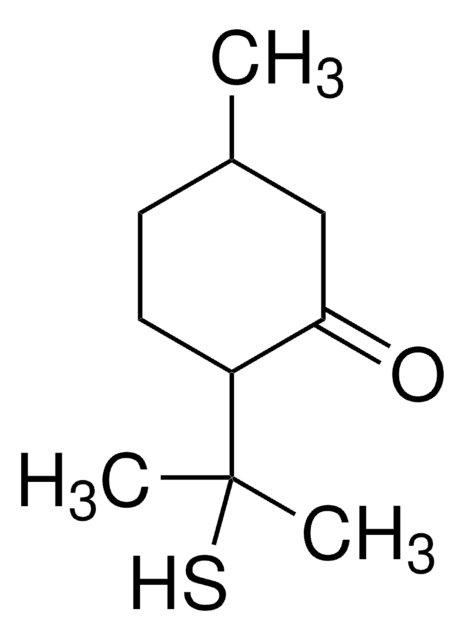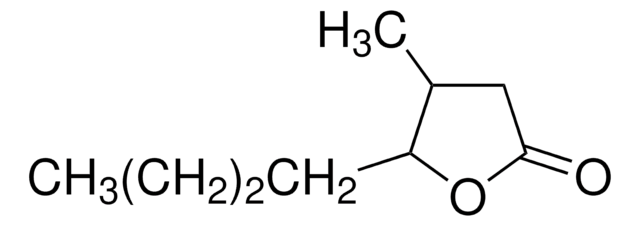W243906
Ethyl hexanoate
≥98%, FCC, FG
Sinônimo(s):
Caproic acid ethyl ester, Ethyl caproate
About This Item
Produtos recomendados
fonte biológica
synthetic
Nível de qualidade
grau
FG
Halal
Kosher
Agency
meets purity specifications of JECFA
conformidade reg.
EU Regulation 1334/2008 & 178/2002
FCC
FDA 21 CFR 117
FDA 21 CFR 172.515
densidade de vapor
5 (vs air)
Ensaio
≥98%
índice de refração
n20/D 1.407 (lit.)
p.e.
168 °C (lit.)
densidade
0.869 g/mL at 25 °C (lit.)
aplicação(ões)
flavors and fragrances
Documentação
see Safety & Documentation for available documents
alérgeno alimentar
no known allergens
Organoléptico
banana; green; waxy; fruity; pineapple; sweet
cadeia de caracteres SMILES
CCCCCC(=O)OCC
InChI
1S/C8H16O2/c1-3-5-6-7-8(9)10-4-2/h3-7H2,1-2H3
chave InChI
SHZIWNPUGXLXDT-UHFFFAOYSA-N
Procurando produtos similares? Visita Guia de comparação de produtos
Categorias relacionadas
Descrição geral
Aplicação
- Formation of Key Aroma Compounds During 30 Weeks of Ripening in Gouda-Type Cheese Produced from Pasteurized and Raw Milk.: The study investigates the formation of key aroma compounds, including ethyl hexanoate, during the ripening of Gouda-type cheese. The results provide insights into the ripening process and its impact on cheese flavor development (Duensing et al., 2024).
Palavra indicadora
Warning
Frases de perigo
Declarações de precaução
Classificações de perigo
Flam. Liq. 3
Código de classe de armazenamento
3 - Flammable liquids
Classe de risco de água (WGK)
WGK 1
Ponto de fulgor (°F)
127.4 °F - closed cup
Ponto de fulgor (°C)
53 °C - closed cup
Equipamento de proteção individual
Eyeshields, Faceshields, Gloves, type ABEK (EN14387) respirator filter
Escolha uma das versões mais recentes:
Já possui este produto?
Encontre a documentação dos produtos que você adquiriu recentemente na biblioteca de documentos.
Os clientes também visualizaram
Global Trade Item Number
| SKU | GTIN |
|---|---|
| W243906-1KG | |
| W243906-20KG | |
| W243906-20KG-K | 4061837544798 |
| W243906-800G | |
| W243906-8KG | |
| W243906-9KG-K | 4061837544811 |
| W243906-1KG-K | 4061837512599 |
| W243906-4KG | |
| W243906-4KG-K | 4061837544804 |
| W243906-9KG | |
| W243906-SAMPLE | |
| W243906-SAMPLE-K | 4061837544828 |
Nossa equipe de cientistas tem experiência em todas as áreas de pesquisa, incluindo Life Sciences, ciência de materiais, síntese química, cromatografia, química analítica e muitas outras.
Entre em contato com a assistência técnica












